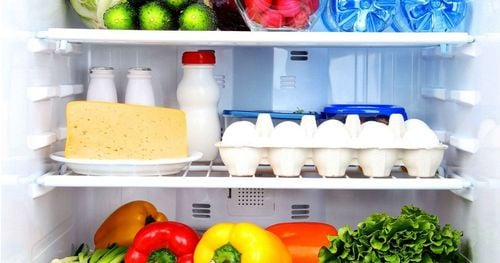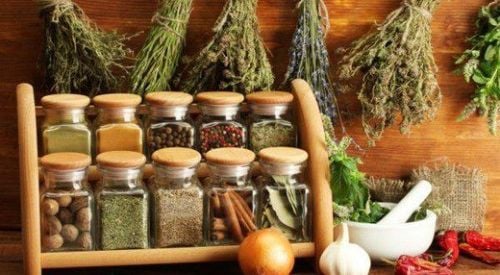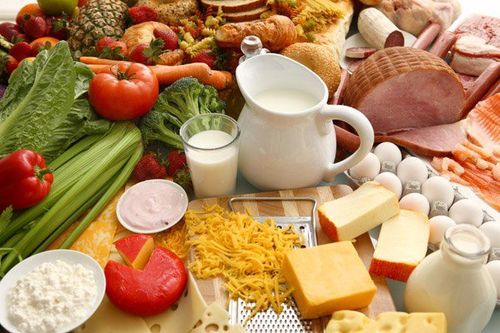This is an automatically translated article.
Preserving processed food is crucial for long-term, safe food storage, whether you plan to use it at home, prepare it in the kitchen of a restaurant, or sell it directly to the consumer. use. Preserving processed foods also slows down the oxidation of fats, helps inhibit the growth of bacteria and ensures the nutritional content of the meal.
1. Why should food be preserved?
Food preservation is in fact a process that includes food preparation practices that prevent the growth of microorganisms (such as yeast) or the introduction of other beneficial microorganisms (some method of preserving processed foods that work by introducing bacteria or fungi into the food) and slowing down the oxidation of rancid fats.
Preservation of processed foods can also include processes that prevent the occurrence of adverse reactions in processed foods, such as enzymatic browning in apples after they have been stored. cut during food processing. From time immemorial, by preserving food, humans have been able to ensure their own food security through food storage and reduction of food waste, thereby increasing the resilience of systems. local food and reduce the environmental impact of food production.
Many of the processes that have been designed to preserve food involve many methods of preserving food. For example, preserving fruit by turning it into jam, including boiling (to reduce the fruit's moisture content and to kill bacteria, etc.), fermenting (to prevent them from re-growing) and canning in airtight jars (to avoid re-infection). Different food preservation methods have different impacts on the quality of food and food systems.
Some traditional food preservation methods have been shown to have lower energy inputs and carbon emissions than modern methods. Meanwhile there are a number of methods of food preservation that have been shown to produce carcinogens. In 2015, the World Health Organization's International Agency for Research on Cancer classified processed meat, i.e. meat that has undergone salting, treatment, fermentation and smoking, as "" carcinogen to humans".
2. Some traditional techniques for preserving processed food
2.1 Food drying This can be considered the earliest form of processed food preservation that humans have ever used, they were applied to life around 12,000 BC. Smoked and salted techniques are also based on drying techniques, which can improve the drying process and add antimicrobial agents to aid in preservation. Smoke deposits a number of pyrolysis products on food, including phenol syringol, guaiacol and catechol. Salt accelerates the drying process using osmosis and also inhibits the growth of some common bacterial strains. Recently, nitrite has been used to give meat its distinctive pink color.
1.2 Refrigeration Refrigeration can preserve food by slowing the growth and reproduction of microorganisms and the activity of enzymes that can cause food to decay. The advent of industrial and household refrigerators has greatly improved the diets of many people around the world by allowing the preservation of foods such as fresh fruits, salads and dairy products. safely for longer periods of time, especially in hot, humid weather conditions.
Before the era of mechanical refrigeration, refrigeration to preserve food was carried out in the form of cellars and freezers. Rural people often cut the ice themselves, while towns and cities often rely on the ice trade. Today, the preservation of food in freezers is still popular among people who value various goals, including local food, heirloom crops, traditional home cooking techniques, farming. family, thrift, self-sufficiency, organic farming and many other factors.
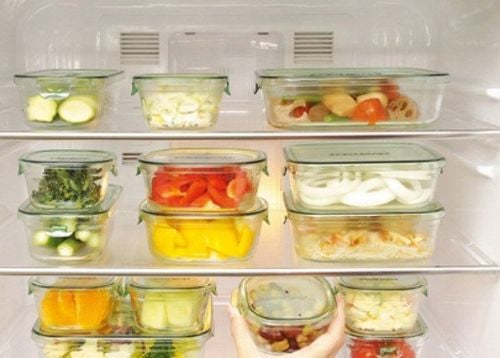
Phương pháp làm lạnh có thể bảo quản thực phẩm đã chế biến
2.3 Freezing food Frozen food preservation is also one of the most commonly used procedures in the preservation of processed foods, both commercial and individual households to preserve a variety of foods. foods, including prepared foods, without having to freeze them first. For example, potato waffles are stored in the freezer, but the potatoes themselves only require a cool dark place to ensure they can last for many months. Cold storages can even provide large volumes, long-term storage of strategic food stocks that are stocked in case of emergency in many countries around the world.
2.4 Boiling Food Boiling liquid foods can kill any currently detected bacteria. Milk and water are usually boiled to kill any harmful bacteria present in them. Heating to a temperature sufficient to kill microorganisms inside food is a method used with stews. Milk is also boiled before storage to kill many microorganisms.
2.5 Preserving foods with sugar Humans have been using sugar since ancient times as a preservative, and preserving fruit in honey is a very popular method. Similar to pickles, cane sugar was brought to Europe through trade routes. In northern climates where there is not enough sunlight to dry food, people preserve it by heating the fruit with sugar. "Sugar tends to draw water from microorganisms (plasmolysis). This process causes the microbial cells to lose water, thus killing them. This way the food will remain safe from spoilage. microbial spoilage." Sugar is used to preserve fruit in the form of an antimicrobial syrup with fruits such as apples, pears, peaches, apricots and plums, or in a crystalline form where the preserved material is cooked in sugar to the point of crystallization. and the resulting product was then stored dry. This method is used for the peels of citrus fruits, angelica and ginger. In addition, sugar can be used in the production of jams and jellies.
2.6 Pickling Pickles Pickling pickles is a method of preserving food in an edible, antibacterial liquid form. Pickles can be classified into two types: chemical pickling and fermented pickling. In chemical pickling, food is placed in an edible liquid to inhibit or kill bacteria and other microorganisms. Typical pickling agents include brine (high salt concentration), vinegar, alcohol, and vegetable oil. Many chemical pickling processes also involve heating or boiling so that the preserved food becomes saturated with the pickling agent. Common pickles include cucumbers, peppers, corned beef, herring and eggs, as well as mixed vegetables like piccalilli. During pickling fermentation, the bacteria in the liquid produce organic acids as preservatives, typically by a process that produces lactic acid through the presence of lactobacillales. Fermented pickles include sauerkraut, nukazuke, kimchi and surströmming.
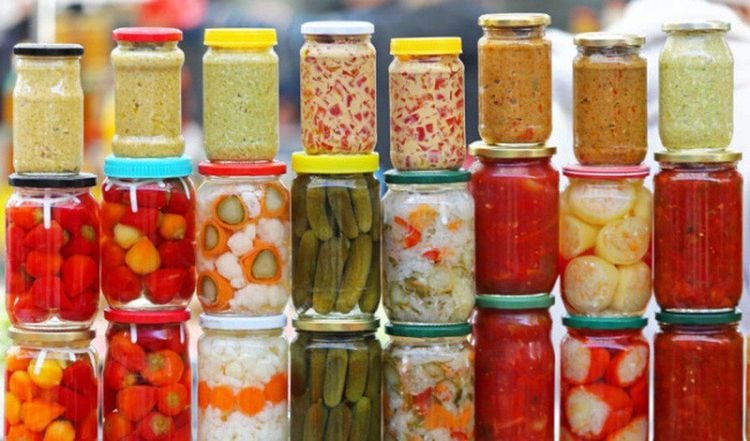
Muối dưa chua là một phương pháp bảo quản thực phẩm ở dạng lỏng có thể ăn được
3. Some modern techniques for preserving processed food
3.1 Pasteurization Pasteurization is a process of preserving processed liquid foods. It was originally applied to anti-sour local wines. Today, this process is mainly applied to dairy products. In this method, milk is heated to about 70°C (158°F) for 15–30 seconds to kill bacteria present in the milk and rapidly cooled down to 10°C (50°F) to prevent residual bacteria. develop again. The milk is then stored in sterilized bottles or bags in cold places. This method was invented by Louis Pasteur, a French chemist, in 1862.
3.2 Vacuum packaging Vacuum packaging is a method of preserving dried foods in a vacuum environment, usually in bags or bottles. airtight. The vacuum environment deprives the bacteria of the oxygen needed for the survival of the bacteria. Vacuum packaging is often used to preserve nuts in order to retain their delicious flavor and prevent them from oxidizing. A major downside to vacuum packaging for consumers, is that vacuum can distort and cause some foods to lose their inherent flavor, such as cheese.
3.3 Preservation of processed foods with artificial food additives Food additives can be antibacterial - inhibiting the growth of bacteria or fungi, including mold - or antioxidants oxidants, such as oxygen absorbers, inhibit the oxidation of food ingredients. Common antimicrobial preservatives include calcium propionate, sodium nitrate, sodium nitrite, sulfites (sulfur dioxide, sodium bisulfite, potassium hydrogen sulfite, etc.), and EDTA. Antioxidants include butylated hydroxyanisole (BHA) and butylated hydroxytoluene (BHT).
Other preservatives include formaldehyde (usually in solution form), glutaraldehyde (pesticide), ethanol, and methylchloroisothiazolinone.
Also another approach is to impregnate the packaging material (plastic film or other) with antioxidants and antibacterial agents, such as butylated hydroxyanisole, butylated hydroxytoluene, tocopherols, hinokitiol, lysozyme, nisin, natamycin , chitosan, and ε-polylysine.
3.4 Food Irradiation Food irradiation is the process of exposing food to ionizing radiation. Various types of ionizing radiation can be used, including beta particles (high-energy electrons) and gamma rays (emitted from radioactive sources such as cobalt-60 or cesium-137). Irradiation can kill bacteria, mold and harmful insects, inhibit ripening and limit fruit spoilage, at higher doses irradiation can make food sterile. This technology can be compared with pasteurization; it is sometimes called "cold pasteurization", because the product is not heated. Irradiation can allow cleaning of foods that are of lower quality or contaminated. Expert bodies around the world have declared food irradiation "healthy"; United Nations organizations, such as the World Health Organization and the Food and Agriculture Organization of the United Nations, have also endorsed food irradiation. Consumers may have a negative view of foods that have been tested. Irradiation is based on the misconception that food is radioactive, however, in reality, irradiated food cannot become radioactive. Some have also voiced opposition to irradiation of food for other reasons, for example, arguing that irradiation can be used to disinfect contaminated food without addressing the underlying cause of the contamination. pollution. Nor does international law prohibit the irradiation of food. About 500,000 tons of food are irradiated each year worldwide in more than 40 countries. These are mostly spices, with more and more fresh fruit being irradiated for fruit fly quarantine.
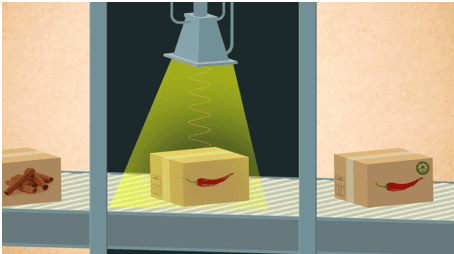
Phương pháp chiếu xạ thực phẩm với với bức xạ ion hóa
3.5 Using Pulsed Electric Fields to Preserve Processed Food Pulsed Electric Field (PEF) is a method of treating cells with short pulses of a strong electric field. Pulsed electric fields have potential as an alternative type of low-temperature pasteurization process for sterilizing food products, especially processed foods. In pulsed electric field processing, a substance is placed between two electrodes, after which a pulsed electric field is applied. The electric field widens the pores of the cell membrane, killing the cells and releasing their contents. Pulsed electric field for food processing is a developing technology that is still being researched. There have been some industrial applications of pulsed electric field processing for juice pasteurization, however, there are still many limitations. To date, several pulsed electric field-treated juices are commercially available in Europe. Furthermore, for several years, a juice pasteurization application in the US used a pulsed electric field. For cytolysis purposes, especially potato processors show great interest in pulsed electric field technology as an effective alternative to their preheaters. The potato application is already active in the US and Canada as well as the commercial application of the pulsed electric field potato in various countries in Europe, as well as in Australia, India and China.
Preserving processed food is a measure that has been applied for a long time to store, avoid food waste, and even protect food security around the world. When technology has not yet developed, people have devised ways to preserve food based on materials available in nature such as salt, sugar, fire.... Nowadays, when technology is applied a lot in food. life, the methods of preserving food are also enhanced. One can even keep certain foods for years without spoiling.
Please dial HOTLINE for more information or register for an appointment HERE. Download MyVinmec app to make appointments faster and to manage your bookings easily.




